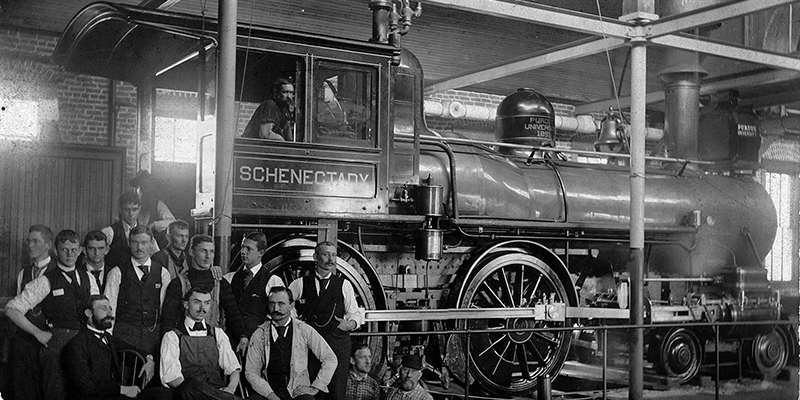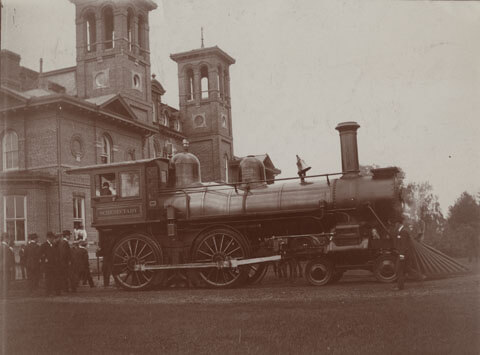Did You Know?: Purdue Locomotive Testing Plant

The Schenectady, the first full-scale locomotive used in the Purdue Locomotive Testing Plant on the West Lafayette campus, is shown around 1895 with students and faculty, including Professor W. Goss, bottom left, and instructor Richard Smart, bottom center. (Photo courtesy of the School of Mechanical Engineering and Purdue University Archives and Special Collections)
From 1892 to 1938, Purdue was the site of innovative railway laboratories that established the University as a leader in transportation research.
By the late 1800s, the railroad industry had become plagued with technical problems that required in-depth research to correct. In 1892, to meet this problem head-on, the University built the Purdue Locomotive Testing Plant, a test site and laboratory space in the center of Heavilon Hall.
The facility was the first of its kind, and it carried out the first laboratory research involving a full-scale locomotive, according to "A University of Tradition: The Spirit of Purdue," a book compiled by the Purdue Reamer Club. The testing plant involved faculty members as well as students, who gained valuable skills and experiences there.
The first locomotive used in the testing plant was the Schenectady, a steam engine that Purdue ordered from Schenectady Locomotive Works in New York. Transporting and installing the locomotive in the University's testing facility was an engineering feat itself, according to the Reamer Club book.
The same year the testing facility was built, the Schenectady arrived near the present-day Purdue Airport at a switch in the local Monon Rail Line. An all-campus holiday was called while faculty and student volunteers helped move the engine to campus. And doing so was no small feat; it took eight days, three teams of horses and a large group of volunteers to move the 85,000-pound Schenectady to Heavilon Hall, which was about a mile and a half away.
 Taken in 1892, this photo shows a group of University volunteers transporting the Schenectady steam engine to the Purdue Locomotive Testing Plant, which was located near Heavilon Hall. In the background is Ladies' Hall, a women's dormitory south of University Hall that was demolished in 1927. It took the volunteers eight days using three teams of horses to move the Schenectady a mile and a half from a switch in the local railroad to the testing plant. (Photo courtesy of Purdue University Archives and Special Collections)
Download image
Taken in 1892, this photo shows a group of University volunteers transporting the Schenectady steam engine to the Purdue Locomotive Testing Plant, which was located near Heavilon Hall. In the background is Ladies' Hall, a women's dormitory south of University Hall that was demolished in 1927. It took the volunteers eight days using three teams of horses to move the Schenectady a mile and a half from a switch in the local railroad to the testing plant. (Photo courtesy of Purdue University Archives and Special Collections)
Download image
In January 1894, the testing plant was destroyed in the same fire that leveled the newly built Heavilon. The Schenectady was pulled from the rubble and sent to Indianapolis for repairs. In the meantime, a new facility called the Locomotive Testing Laboratory was built just north of Heavilon.
When the refurbished Schenectady returned to campus, bringing it to the new laboratory was easier thanks to the recently built Purdue Railroad, which led from the switch near the present-day airport straight to the Locomotive Testing Laboratory. At just 1 1/4 miles long, the Purdue Railroad was considered the shortest line in the world, according to the Reamer Club book.
The Purdue Railroad proceeded north from the Monon Rail Line switch, east toward campus along what is now Harrison Street and then across State Street between Matthews and Stone halls. The tracks continued over the present-day site of the Class of 1950 Lecture Hall and on to the Locomotive Testing Laboratory.
Research at the laboratory continued through 1922; over the years, several locomotives were used at the facility. They included the Schenectady II and III as well as an engine called Vauclain, Purdue No. 4. Railway parts such as brakes, axles, draft gears and a dynamometer, on which a train engine ran and was tested while stationary, also were used in the laboratory.
The research conducted at Purdue's locomotive testing facilities led to several major advances in railroad technology. For instance, an air brake system designed at Purdue eventually was required on all trains in the U.S. This system enabled all of a train's cars to brake simultaneously, reducing the risk of derailment.
By 1938, many railroad companies had stopped funding research and development, and fewer students were enrolled in Purdue's locomotive research program, according to the Reamer Club book. As a result of that and the fact that the Vauclain, Purdue No. 4 boiler was declared unsafe, the University halted research at the Locomotive Testing Laboratory.
Purdue's railroad equipment went unused for several years until it was sold for scrap during World War II. Much of the University's collection of historical railroad equipment, which previously had been showcased in the University's now-shuttered Locomotive Museum, was transported to the St. Louis Museum of Transportation, where it is still on display.
The test facility was then given to the Department of Chemistry for use in the Manhattan Project, according to the Reamer Club book. It was renamed the Chemical Research Laboratory
The laboratory was noted on campus maps until 1968, after which it was demolished to make way for new buildings, according to documents housed in the Virginia Kelly Karnes Archives and Special Collections Research Center.

